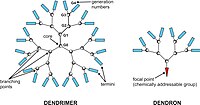
Reducing the Singlet-Triplet Energy Gap by End-Group π-π Stacking Toward High-Efficiency Organic Photovoltaics.
Sign Up to like & getrecommendations! Published in 2020 at "Advanced materials"
DOI: 10.1002/adma.202000975
Abstract: To improve the power conversion efficiencies for organic solar cells, it is necessary to enhance light absorption and reduce energy loss simultaneously. Both the lowest singlet (S1) and triplet (T1) excited states need to energertically… read more here.
Keywords: singlet triplet; energy; triplet; end group ... See more keywords

Fluorinated End Group Enables High‐Performance All‐Polymer Solar Cells with Near‐Infrared Absorption and Enhanced Device Efficiency over 14%
Sign Up to like & getrecommendations! Published in 2020 at "Advanced Energy Materials"
DOI: 10.1002/aenm.202003171
Abstract: Fluorination of end groups has been a great success in developing efficient small molecule acceptors. However, this strategy has not been applied to the development of polymer acceptors. Here, a dihalogenated end group modified by… read more here.
Keywords: high performance; polymer; polymer solar; end group ... See more keywords

The Effect of End Group and Molecular Weight on the Yellowness of Polyetherimide.
Sign Up to like & getrecommendations! Published in 2018 at "Macromolecular rapid communications"
DOI: 10.1002/marc.201800045
Abstract: The effects of end group and molecular weight on the yellowness of telechelic polyetherimide (PEI) are investigated. Electron-withdrawing dianhydride end groups reduce the yellowness and increase the transparency of PEI regardless of the molecular weight.… read more here.
Keywords: molecular weight; end group; weight; group molecular ... See more keywords

End group Functionality of 95 to 99%: Epoxide Functionalization of Polystyryl-Lithium Evaluated via Solvent Gradient Interaction Chromatography (SGIC).
Sign Up to like & getrecommendations! Published in 2022 at "Macromolecular rapid communications"
DOI: 10.1002/marc.202200560
Abstract: End group functionality is a key parameter of functional polymer chains. The end-capping efficiency of living polystyryl lithium with various epoxides, namely ethylene oxide (EO), ethoxy ethyl glycidyl ether (EEGE) and isopropylidene glyceryl glycidyl ether… read more here.
Keywords: solvent gradient; group functionality; group; end group ... See more keywords

End Group Effect of Asymmetric Benzodithiophene-Based Donor with Liquid-Crystal State for Small-Molecule Binary Solar Cell.
Sign Up to like & getrecommendations! Published in 2022 at "Small"
DOI: 10.1002/smll.202205244
Abstract: Liquid-crystal small molecule donor (LC-SMD) is a new type organic semiconductor, which is attractive not only for the easy synthesis and purification, well-defined chemical structures, etc., but also for the LC state that makes the… read more here.
Keywords: small molecule; state; liquid crystal; end group ... See more keywords

Substituents on the end group subtle tuning the energy levels and absorptions of small-molecule nonfullerene acceptors
Sign Up to like & getrecommendations! Published in 2018 at "Dyes and Pigments"
DOI: 10.1016/j.dyepig.2018.03.061
Abstract: Abstract Two new small-molecule nonfullerene acceptors containing methyl- and fluorine-substituted 2-(2,3-dihydro-3-oxo-1H-inden-1-ylidene)propanedinitrile (INCN) as end groups, namely, NFBDT-Me and NFBDT-F, were designed, synthesized and applied in organic solar cells. The influence of the methyl and fluorine… read more here.
Keywords: nonfullerene acceptors; molecule; small molecule; end group ... See more keywords

Promoting carboxylate salts in the ESI source to simplify positive mode MS/MS sequencing of acid-terminated encoded polyurethanes
Sign Up to like & getrecommendations! Published in 2020 at "International Journal of Mass Spectrometry"
DOI: 10.1016/j.ijms.2019.116271
Abstract: Abstract Synthetic polymers prepared by solid-phase processes are often released from the solid support by hydrolysis, leading to an acidic α chain-end which can usefully be employed to perform mass spectrometry experiments in the negative… read more here.
Keywords: mode; carboxylate salts; positive mode; end group ... See more keywords

Tuning morphology of Pickering emulsions stabilised by biodegradable PLGA nanoparticles: How PLGA characteristics influence emulsion properties.
Sign Up to like & getrecommendations! Published in 2021 at "Journal of colloid and interface science"
DOI: 10.1016/j.jcis.2021.03.061
Abstract: In this study, we proved that the stabilisation of Pickering emulsions by polymer nanoparticles (NPs) heavily depends on polymer characteristics. We prepared NPs with four poly(lactide-co-glycolide) polymers (PLGA), of different molar masses (14,000 and 32,000 g/mol)… read more here.
Keywords: end group; emulsion; plga characteristics; pickering emulsions ... See more keywords

Effect of end-group modification of poly(lactide)s by cinnamoyl chloride on their thermal stability
Sign Up to like & getrecommendations! Published in 2017 at "Polymer Degradation and Stability"
DOI: 10.1016/j.polymdegradstab.2017.05.015
Abstract: Abstract In order to improve thermal stability of poly( l -lactide) (PLLA), the terminal hydroxy groups of PLLAs were converted to cinnamate esters by the treatment with cinnamoyl chloride. The resulting end-group modified PLLAs exhibited… read more here.
Keywords: poly lactide; end group; stability; modification ... See more keywords

Neurocognitive and Self-efficacy Benefits of Cognitive Remediation in Schizophrenia: A Randomized Controlled Trial – Corrigendum
Sign Up to like & getrecommendations! Published in 2019 at "Journal of the International Neuropsychological Society"
DOI: 10.1017/s1355617719000535
Abstract: In the article by Bryce et al. (2018) incorrect standard deviations were used when calculating the reliable change indices presented in this article. While the correct standard deviation (SD) was used in calculating the Matrics… read more here.
Keywords: change; page; end group; line ... See more keywords

Activating ATRP Initiators to Incorporate End-Group Modularity into Photo-RAFT Polymerization
Sign Up to like & getrecommendations! Published in 2020 at "Macromolecules"
DOI: 10.1021/acs.macromol.0c01697
Abstract: Heterogeneous photocatalysis is increasingly used in reversible deactivation radical polymerization (RDRP). In this study, we found that alkyl bromide redox chemistry typically found in atom transf... read more here.
Keywords: polymerization; atrp initiators; initiators incorporate; end group ... See more keywords